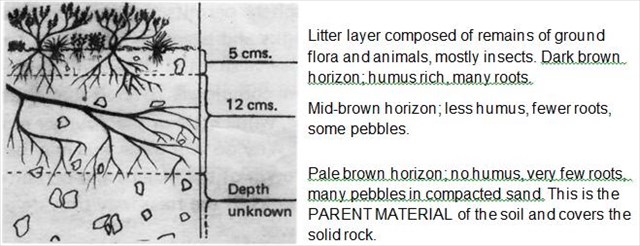Glen Derby Daunder - trout beck EarthCache
geoawareUK2: As this cache has not been enabled again, it is being re-archived.
GeoawareUK2
Glen Derby Daunder - trout beck
-
Difficulty:
-

-
Terrain:
-

Size:  (other)
(other)
Please note Use of geocaching.com services is subject to the terms and conditions
in our disclaimer.
A daunder is the old Scot's word for a stroll or a walk. The Glen Derby Daunder is a series of 6 traditional caches and 1 earthcache to encourage my fellow Geocachers to take a stroll up Glen Derby from Kirkmichael village to visit a remote, beautifully located and rarely visited cache, Atholl Walks Glen Derby (GCQ96Y) set by Snaik.
_________________________________________________________________________________________________
Please do not attempt to drive up Glen Derby to do this cache.
_________________________________________________________________________________________________
This is an EARTHCACHE in the Glen Derby Daunder series and is along an old drover's road.
Walking boots and warm clothing are essential.
A beck is a small stream.
_______________________________________________________________________________________________________
Rocks can be classified as one of three types:
Igneous rock is formed as molten magma flows and cools. A variety of igneous rock types can be formed depending on the chemical make-up of the magma and the amount of cooling. Quick cooling tends to produce coarser-grained rock types such as the granites, whilst slower cooling gives finer grained rocks like basalt.
Sedimentary rock, as its name implies, is formed from sediments often laid down in horizontal layers and derived from the erosion of earlier rock types such as sandstone or shale.
Metamorphic rock is formed when any type of rock is subjected to pressure or heat. This can occur in the deep core of a mountain range as it is being formed. Examples of the resulting metamorphic rock are slate, schist or gneiss, depending on its original rock composition and the pressure and temperature reached.
Examples of these rock types - sedimentary, metamorphic and igneous – are found within Glen Derby.
Glen Derby is underlain by a series of ancient metamorphic rocks originally formed during the Precambrian and Cambrian era, collectively known as the ‘Dalradian Supergroup’. The Dalradian was originally a thick succession of sediments and lava flows, that was metamorphosed under great heat and pressure during mountain-building events around 500-400 million years ago created by continental collisions.
They underlie the mainly peat- and glacial till-covered plateaux, glens and peaks in the area.
During the late Quaternary (30 to 15 thousand years ago) a major ice sheet moved eastwards down Glen Derby towards Strathardle. As the glacier and ice sheets flowed along the glen, they eroded rocks from highland areas and deposit the debris at lower levels. With the climate becoming drier and warmer at the end of this Ice Age, the ice retreated from the main glen, leaving a blanket of "ground moraine" (glacial till) on the slopes.
In higher tributary valleys such as Glen Derby, the small glaciers continued to retreat unevenly, leaving many ridges, hummocks of till and depositing boulders carried by the glaciers. Small channels cut by meltwater from the glaciers are common. _______________________________________________________________________________________________________
Glen Derby runs from the high hills in the west down to Strathardle. The type of soil developed over the centuries depends mostly on the parent material below, the local climate, and the animals and vegetation living and growing in the upper layers of the soil. Trees and other plants require nutrients and water. They obtain this from the soil through their roots.
The silt is formed as the pale brown parent material (deposited here by ice) which is broken down by the activity of soil organisms, plant roots, and weather. The humus comes from decaying vegetation. This sort of soil is called a BROWN EARTH.
Heather, which is the dominant plant species here, indicates that it is acidic soil.
_________________________________________________________________________________________________
Now the tasks you have to carry out for this Earthcache.
Go to the first roadside waypoint which is a group of objects on the right hand side of the road going uphill from Kirkmichael village.
1. What geological features do you see and how might they have ended up here ?
Go to the Soil Profile waypoint Look at the banking at the right hand side of the road going up from Kirkmichael that has become exposed. (There are other exposed soil profiles at the side of the road as you make your way up the glen.) You will see that this shows a profile of the soil in which trees and other plants are growing. This is the type of profile commonly found as you move higher up the slopes of Glen Derby.

Rub a little of the mid-brown layer between your thumb and index finger you will feel its texture.
Now rub a little of the pale brown layer between your thumb and index finger to feel its texture.
2. What is the diffence between the texture of the these two layers ?.
3. At the co-ordinates given for this cache, which hydrological feature do you see at each side of the road and how might it have been formed ?
4. Where does the humus come from in the litter layer and the mid-brown horizon.
To log this cache you should email your answers to questions 1, 2, 3 and 4 to me. Do not put your answers on the cache page.
_______________________________________________________________________________________________________
The is an EARTHCACHE and there is no cache container. _______________________________________________________________________________________________________
 Congratulations to snaik for being FTF this Geocache. __________________________________________________________________________________________________________________________
Congratulations to snaik for being FTF this Geocache. __________________________________________________________________________________________________________________________
Additional Hints
(No hints available.)